Polish Land Forces
The Land Forces (Polish: Wojska Lądowe) are a military branch of the Polish Armed Forces. They currently contain some 77,000[1] active personnel and form many components of the European Union and NATO deployments around the world. Poland's recorded military history stretches back a millennium – since the 10th century (see List of Polish wars and History of the Polish Army), but Poland's modern army was formed after the country regained independence following World War I in 1918.
| Land Forces | |
|---|---|
| Wojska Lądowe | |
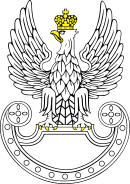 | |
| Founded | 1918 |
| Country | Poland |
| Type | Ground forces |
| Size | 77,000 military[1] 1,010 tanks 3,110 IFV/APC 250 helicopters[2] |
| Part of | Polish Armed Forces |
| Headquarters | Warsaw |
| March | "Marsz Pierwszej Brygady" (English: "March of the First Brigade") |
| Engagements | Polish–Ukrainian War Polish–Czechoslovak War Polish–Soviet War Polish–Lithuanian War World War II War in Iraq War in Afghanistan EU Force Chad/CAR |
| Commanders | |
| Chief of the General Staff | gen. broni Rajmund Andrzejczak |
| General Commander | gen. broni Jarosław Mika |
| Inspector of the Land Forces | gen. bryg. Wojciech Grabowski |
| Insignia | |
| Flag |  |
| Banner of the Commander in Chief |  |
History
1918–1938

When Poland regained independence in 1918, it recreated its military which participated in the Polish–Soviet War of 1919–1921, and in the two smaller conflicts ( Polish–Ukrainian War (1918–1919) and the Polish–Lithuanian War (1920)).
Initially, right after the First World War, Poland had five military districts (1918–1921):
- Poznań Military District (Poznański Okręg Wojskowy), HQ in Poznań
- Kraków Military District (Krakowski Okręg Wojskowy), HQ in Kraków
- Łódź Military District (Łódzki Okręg Wojskowy), HQ in Łódź
- Warsaw Military District (Warszawski Okręg Wojskowy), HQ in Warsaw
- Lublin Military District (Lubelski Okręg Wojskowy), HQ in Lublin.
The Polish land forces as readied for the Polish–Soviet War was made up of soldiers who had formerly served in the various partitioning empires, supported by some international volunteers.[3] There appear to have been a total of around 30 Polish divisions involved. Boris Savinkov was at the head of an army of 20,000 to 30,000 largely Russian POWs, and was accompanied by Dmitry Merezhkovsky and Zinaida Gippius. The Polish forces grew from approximately 100,000 in 1918 to over 500,000 in early 1920.[4] In August 1920, the Polish army had reached a total strength of 737,767 people; half of that was on the frontline. Given Soviet losses, there was rough numerical parity between the two armies; and by the time of the Battle of Warsaw Poles might have even had a slight advantage in numbers and logistics.[5]
Among the major formations involved on the Polish side were a number of Fronts, including the Lithuanian-Belarusian Front, and about seven armies, including the First Polish Army.
1939–1945
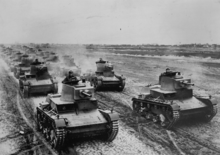
The German invasion of Poland began on 1 September 1939, and the Wehrmacht seized half the country quickly despite heavy Polish resistance. Among the erroneous myths generated by this campaign were accounts of Polish cavalry charging German tanks, which did not, in fact, take place. In the east, the Red Army took the other half of the country in accordance with the Nazi-Soviet Pact. Following the country's fall, Polish soldiers began regrouping in what was to become the Polish Army in France. Both the Polish Armed Forces in the West and the Polish Armed Forces in the East, as well as interior (partisan) forces, primarily represented by the Home Army (AK) had land forces during the Second World War. While the forces fighting under the Allied banner were supported by the Polish Air Force and Navy, the partisan forces were an exclusive land formation.
However the army operational today has its roots in the surrogate force formed in support of Soviet interests during the establishment of the People's Republic of Poland after the Second World War. Two Polish armies, the First Army (Poland) and the Second Army fought with the Red Army on the Eastern Front, supported by some Polish Air Force elements. The formation of a Third Army was begun but not completed.
1945–1989
 |
| Polish Armed Forces |
|---|
| Branches |
|
|
| History |
|
Timeline Wars |
| Personnel |
|
Senior officers Rank insignia Awards Oaths |
| Equipment |
|
Land Forces Navy |

The end of the war found the Polish Army in the midst of intense organisational development. Although the implementation of the Polish Front concept was abandoned, new tactical unit and troop types were created. As a result of mobilisation, troop numbers in May 1945 reached 370,000 soldiers, while in September 1945 440,000. Military districts were organised in liberated areas. The districts exercised direct authority over the units stationed on the territory administered by them. Returning to the country, the Second Army was tasked with the protection of the western border of the state from Jelenia Gora to Kamien Pomorski, and on the basis of its headquarters, the staff of the Poznan Military District was created at Poznań. The southern border, from Jelenia Gora to the Użok railway station (at the junction of the Polish, the Soviet and the Czechoslovak borders) was occupied by the First Army. Its headquarters staff formed the basis of the Silesian Military District.
In mid-1945, after the end of World War II, the Polish Army, as part of the overall armed forces, the People's Army of Poland, was divided into six (later seven) districts. These were the Warsaw Military District, HQ in Warsaw, the Lublin Military District, HQ in Lublin, the Kraków Military District, HQ in Kraków, the Lodz Military District, HQ in Lodz, the Poznan Military District, HQ in Poznan, the Pomeranian Military District, HQ in Torun (formed from the staff of the short-lived LWP 1st Army Corps) and the Silesian Military District, HQ in Katowice, created in the fall of 1945.
In June 1945 the 1st, 3rd and 8th Infantry Divisions were assigned internal security duties, while the 4th Infantry Division was reorganised for the purpose of creating the Internal Security Corps (KBW). The rule was that military units were used primarily against the Ukrainian Insurgent Army (UPA), while the Internal Security Corps was used to fight the armed underground independence. Often however army units fought the underground resistance, and vice versa. The culmination of the UPA suppression operation was the so-called 'Wisła Action' (Operation Vistula) which took place in 1947. At the same time demobilisation took place, moving the armed forces to a peace-time footing. On 10 August 1945 a "decree of the partial demobilisation" of the armed forces was issued. The next demobilisation phase took place in February and December 1946.
One of the most important tasks facing the army after the war was national mine clearance. Between 1944 and 1956 the demining operation involved 44 engineering units or about 19,000 sappers. They cleared mines and other munitions in a clearance area of more than 250,000 square kilometers (80% of the country). 14.75 million munitions of various types and 59 million bullets, bombs and other ammunition were found and removed. The mining operations cost the lives of 646 sappers.
In 1949 the military districts were reduced to four. They were the Pomeranian Military District, HQ in Bydgoszcz, the Silesian Military District, HQ in Wroclaw, the Warsaw Military District, HQ in Warsaw, and the Kraków Military District with its headquarters in Kraków. In November 1953, the Kraków Military District was dissolved and until 1992, Poland was divided into three Districts.
Following victory and the movement of Polish borders these troops and other Polish soldiers thought loyal to their Soviet overlords were built up into a force which was to form part of the Warsaw Pact. Polish Army troops would have formed part of the second strategic echelon deployed for an attack on NATO's Allied Forces Central Europe. A Polish Front headquarters was formed in 1958, along with three armies formed from 1955, the First Polish Army, the Second Army, and the Fourth Army, mobilisation-only headquarters that were to be formed within the three districts.[6] The Polish Front headquarters was eventually deactivated in 1990, and the three army mobilisation scheme was likewise abandoned. Polish land forces during the communist era also included troops dedicated to internal security – the Territorial Defence Forces – and control of the country's borders.[7]
Until the fall of communism the army's prestige continued to fall, as it was used by the communist government to violently suppress several outbursts of protest, including the Poznań 1956 protests, the Polish 1970 protests, and protests during Martial law in Poland in 1981–1982. Troops of the Silesian Military District also took part in the suppressing of the 1968 democratisation process of Czechoslovakia, commonly known as the Prague Spring.
In 1989 the Pomeranian Military District controlled the 8th, 12th, 15th, 16th, and 20th Divisions, the Silesian Military District controlled the 2nd, 4th, 5th, 10th, and 11th Divisions, and the Warsaw Military District the 1st, 3rd, and 9th Divisions, plus the 6th Airborne Division earmarked for Front control.[8] The 7th Sea Landing Division was based within the Pomeranian Military District but probably earmarked for Front control. The two districts facing Germany each controlled four divisions in 1990, which had been recently reorganised, in line with the late 1990s Soviet defensive doctrine, from a 3:1 mix of motor rifle : tank regiments into a 2:2 mix of motor rifle and tank regiments.[9] The Warsaw Military District in the east controlled only the 1st Mechanised Division. Two other mechanised divisions in that district had been disbanded in 1988. There was also the 6th Airborne Division and the 7th Sea Landing Division, possibly intended to form part of a Warsaw Pact attack on Denmark, to open the Baltic straits to the North Sea and beyond. Strength counted 205,000 personnel of which 168,000 were conscripts.
After 1989
Following the end of the Cold War the Wojska Lądowe was drastically reduced and reorganised. In 1992, the Kraków Military District was recreated. From nine divisions, the total was planned in 2001 to fall to four, plus six independent brigades.[10] Since 1 January 1999, Poland has been divided into two military districts. These are the Pomeranian Military District (Pomorski Okręg Wojskowy) with HQ in Bydgoszcz, covering northern Poland, and the Silesian Military District (Śląski Okręg Wojskowy) with HQ in Wrocław, covering southern Poland.
From that date the former Krakow Military District became the headquarters of the Air-Mechanized Corps, which in turn later became the headquarters of the 2nd Mechanised Corps. On 1 September 2011 the 1st Warsaw Mechanised Division was disbanded.
General Edward Pietrzyk served as commander of the Polish Land Forces from 2000 to September 2006. He was succeeded by General Waldemar Skrzypczak (2006–2009).
In May 2014, Defence Minister Tomasz Siemoniak announced plans for the future acquisition of attack helicopters in response to the Ukraine crisis.[11] On 25 November 2015, chief of National Defence Commission Michał Jach, indicated the necessity to increase the number of Polish troops from 100,000 to 150,000. However, Jach stressed that the process was complicated and should not be rushed.[12]
Participation in peacekeeping operations
From the 1950s the Polish Land Forces have contributed troops to peacekeeping operations, initially the Neutral Nations Supervisory Commission in Korea. Poland contributed troops to UNIFIL in Lebanon since 1982, but it was announced in April 2009 that Polish troops would withdraw completely by October 2009.[13] Poland sent a divisional headquarters and a brigade to Iraq after the 2003 Iraq war. Poland sent ten rotations of troops, manning a significant portion of Multinational Division Central-South. At its peak Poland had 2,500 soldiers in the south of the country. Poland deployed about ten attack and transport helicopters as part of its force in Iraq between 2004 and 2008.[14] These helicopters formed the Independent Air Assault Group (pl:Samodzielna Grupa Powietrzno-Szturmowa). The division was disbanded in 2008, though Polish advisory and training personnel, seemingly a Military Advisory Liaison Team (MALT) stayed until at least 2011 (see pl:PKW Irak). One of the most recent missions was MINURCAT in Chad and the Central African Republic, where Poland despatched troops from 2007 to 2010. Among the deployed troops were two Reconnaissance companies, a Military Gendarmerie unit, a component of the 10th Logistics Brigade, elements of the 5th Military Engineers Regiment, and three Mil Mi-17 helicopters.
Equipment
.jpg)
.jpg)

.png)
.jpg)
.jpg)
.jpg)
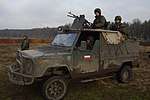

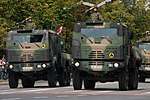
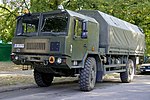 Jelcz 442.32 truck
Jelcz 442.32 truck- Rosomak WRT

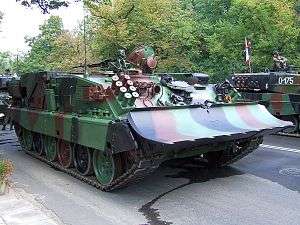
.jpg)
.jpg)

Modernization of Land Forces
The armed forces of the Polish Republic have a long-term plan for the modernization of the army. It has the task of replacing used equipment over a decade with new equipment. Some of this system already works. The Leopard 2 A4 tanks will be upgraded to Leopard 2PL (first Leopard 2 PL arrive in March 2018) by the end of 2023. Now the Polish Army has a stock of 1009 tanks (2017). There are a total of 249 Leopard 2 tanks in 137 Leopard 2 A4, 105 Leopard 2 A5, 5 Leopard 2PL (modernized version of Leopard 2A4. Ministry of Defence signed a contract on modernization of all Leopard 2A4 used by Polish Army to 2023)[15], 2 Leopard 2 NJ, 232 PT-91 tanks that underwent modernization in 2016 and 328 T-72. 230 T-72 tanks will be upgraded in Bumar-Labedy through, inter alia, the installation of new radio stations, digital start-up system, 3rd generation thermal imaging cameras, external transport baskets and they have undergone major repairs. [16]
The Polish army has about 863 vehicles of the KTO Rosomak[17]. BWP-1 will be going to replaced by the BWP Borsuk infantry fighting vehicles (the first prototypes are already in place). Introduction of Borsuk will be started about 2023[17] .
New rifles FB MSBS Grot, pistols Vis-100 were brought into service, to suplement already used FB Beryl rifle and replace FB P-83 Wanad pistols and AKM rifles.[18]
Introduced are the WR-40 Langusta rocket launchers equipped with state-of-the-art Topaz fire control. In 2019 Ministry od Defender order 20 launchers of M142 HIMARS and support vehicles.[19] The AHS Krab self-propelled new AHS Krab, which will replace 2S1 Goździk, new AHS Kryl will replace wz. 1977 Dana. The M120K Rak mortar have been already delivered in 2017. Polish ordered 122 mortars, 60 command vehicles (based on KTO Rosomak) and support vehicles.[20] From 2016 to the service are new technical recognition vehicles Rosomak WRT. In 2022, the so-called soldier of the prodigal TYTAN. This is an integrated combat system that includes a personal soldier's computer, new protective uniforms, night vision devices, etc.
Rank insignia
- Officers
| NATO Code | OF-9 | OF-8 | OF-7 | OF-6 | OF-5 | OF-4 | OF-3 | OF-2 | OF-1 | |
|---|---|---|---|---|---|---|---|---|---|---|
 Army |
 |
 |
 |
 |
 |
 |
 |
 |
 |
 |
| Polish name | Generał1 | Generał broni |
Generał dywizji |
Generał brygady |
Pułkownik | Podpułkownik | Major | Kapitan | Porucznik | Podporucznik |
| Abbreviation | gen. | gen.broni | gen.dyw. | gen.bryg. | płk | ppłk | mjr | kpt. | por. | ppor. |
| U.S./U.K. equivalent | General | Lieutenant General |
Major General |
Brigadier General, Brigadier |
Colonel | Lieutenant Colonel |
Major | Captain | First Lieutenant, Lieutenant |
Second Lieutenant |
|
1 Until 2004 Generał armii | ||||||||||
- Enlisted
| NATO Code | OR-9 | OR-8 | OR-7 | OR-6 | OR-5 | OR-4 | OR-3 | OR-2 | OR-1 | ||
|---|---|---|---|---|---|---|---|---|---|---|---|
 Army |
 |
 |
 |
 |
 |
 |
 |
 |
 |
 |
 |
| Polish name | Starszy chorąży sztabowy |
Starszy chorąży |
Chorąży | Młodszy chorąży |
Starszy sierżant |
Sierżant | Plutonowy | Starszy kapral |
Kapral | Starszy szeregowy |
Szeregowy |
| Abbreviation | st.chor.szt. | st.chor. | chor. | mł.chor. | st.sierż. | sierż. | plut. | st.kpr. | kpr. | st.szer. | szer. |
| U.S./Commonwealth equivalent | Command Sergeant Major |
Sergeant Major |
Master Sergeant |
Sergeant 1st Class |
Staff Sergeant |
Sergeant | Corporal | Specialist Lance corporal |
Private 1st Class |
Private E-1 | Private E-2 |
Structure


5 Engineer Rgt.
Formations
- 11th Armoured Cavalry Division (Żagań)
- 10th Armoured Cavalry Brigade (Świętoszów)
- 17th Mechanized Brigade (Międzyrzecz)
- 34th Armoured Cavalry Brigade (Żagań)
- 12th Mechanised Division "Szczecin" (Szczecin)
- 2nd Legion Mechanized Brigade (Złocieniec-Budowo)
- 7th "Pomeranian" Coastal Defence Brigade (Słupsk)
- 12th Mechanised Brigade (Szczecin)
- 16th "Pomeranian" Mechanised Division (Elbląg)
- 9th Armoured Cavalry Brigade (Braniewo)
- 15th "Giżycka" Mechanized Brigade (Giżycko)
- 20th "Bartoszycka" Mechanized Brigade (Bartoszyce)
- 18th "Żelazna" Mechanised Division (Siedlce)[21]
Independent Units
Arms of Service
- Armored & Mechanized Forces (Wojska Pancerne i Zmechanizowane)
- Missile & Artillery Forces (Wojska Rakietowe i Artyleria)
- Air Defense Forces (Wojska Obrony Przeciwlotniczej)
- Air-mobile (Airborne forces) Forces (Wojska Aeromobilne)
- Engineer Forces (Wojska Inżynieryjne)
- Reconnaissance & Early Warning (Rozpoznanie i Wczesne Ostrzeganie)
- Signals & Information Technology Forces (Wojska Łączności i Informatyki)
- Chemical Forces (Wojska Chemiczne)
- Logistics (Logistyka)
See also
References
- "WPROWADZENIE". Archived from the original on 11 October 2010. Retrieved 12 January 2011.
- ":: Ministerstwo Obrony Narodowej – serwis internetowy :: Uzbrojenie ::". Mon.gov.pl. Archived from the original on 2 March 2012. Retrieved 20 November 2011.
- Janusz Cisek, Kosciuszko, We Are Here: American Pilots of the Kosciuszko Squadron in Defense of Poland, 1919–1921, McFarland & Company, 2002, ISBN 978-0-7864-1240-2, Google Print Archived 24 October 2012 at the Wayback Machine
- Davies, Norman Richard (2003) [1972]. White Eagle, Red Star: the Polish-Soviet War, 1919–20 (New ed.). New York City: Pimlico / Random House Inc. ISBN 978-0-7126-0694-3., p83
- Davies, White Eagle..., Polish edition, p.162 and p.202.
- Andrew A. Michta, 'Red Eagle: the army in Polish politics 1944–1988,' Hoover Press, 1990, p.54. Michta says that in 1958, Poland's deputy defence minister, General Duszynski, suggested that the Inspectorate of Training become the nucleus of a 'Polish Front.' According to the plan, in wartime, fifteen Polish divisions would operate in three armies as a 'Front' under a Polish commander. According to one source, the Soviets accepted the proposal and allowed the Inspectorate of Training to become the skeleton for the front. The notion of the front was modified in the mid 1960s and General Duszynski was dismissed in 1964. See also Michta, 1990, p.56.
- Glenn E. Curtis (ed.), Poland : a country study, p. 267, Washington: GPO, 1994
- "Poland Army 1989". Archived from the original on 3 March 2012. Retrieved 25 December 2011.
- Chris Westhorp, 'The World's Armies,' Salamander Books, 1991, p.92 ISBN 0-517-05240-7. See also Jane's Soviet Intelligence Review for March 1990.
- Grzegorz Holdanowicz, 'Polish government agrees to modernisation plan,' Jane's Defence Weekly, 4 February 2001
- "Poland to accelerate arms programmes". Jane's Information Group. Archived from the original on 31 May 2014. Retrieved 31 May 2014.
- "Defence official: Polish armed forces to be increased by half". Archived from the original on 26 November 2015. Retrieved 27 November 2015.
- 'Poland to withdraw from UN's UNIFIL mission in Lebanon,' Archived 3 April 2012 at the Wayback Machine, 11 April 2009
- 6 PZL W-3 Sokół Helicopters (2003–2006) and four W-3 helicopters 2007–08 <http://gdziewojsko.wordpress.com/listy/w-3-sokol Archived 24 December 2011 at the Wayback Machine>. 6 Mil Mi-24 attack helicopters (2004–2008) <"Śmigłowce Mi-24 rozpoczęły wykonywanie zadań w Iraku". Archived from the original on 23 December 2011. Retrieved 19 November 2011.>. 4 Mil Mi-8 helicopters (2003–2008).
- "PGZ przekazała pierwsze Leopardy 2PL". www.milmag.pl (in Polish). Retrieved 9 July 2020.
- Zbiam. "Modyfikacja czołgów T-72". Wydawnictwo militarne ZBIAM (in Polish). Retrieved 10 July 2020.
- "Po epoce Rosomaka czas na Borsuka?". DziennikZbrojny.pl (in Polish). Retrieved 24 June 2020.
- "Kolejne Groty i Visy 100". www.milmag.pl (in Polish). Retrieved 10 July 2020.
- Adamowski, Jaroslaw (3 September 2019). "Poland to sign $414 million deal for rocket launchers". Defense News. Retrieved 10 July 2020.
- "Szczegóły zamówienia trzeciej partii moździerzy Rak". Radar (in Polish). 28 April 2020. Retrieved 10 July 2020.
- "Minister Blaszczak decided to create a new division". Polish Ministry of Defense. Archived from the original on 16 September 2018. Retrieved 16 September 2018.
External links
| Wikimedia Commons has media related to Dowództwo Wojsk Lądowych. |